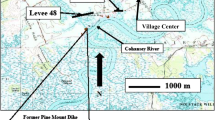Abstract
The rationale and outline of an implementation plan for restoring coastal wetlands in Louisiana is presented. The rationale for the plan is based on reversing the consequences of documented cause-and-effect relationships between wetland loss and hydrologic change. The main feature is to modify the extensive interlocking network of dredged spoil deposits, or spoil banks, by reestablishing a more natural water flow at moderate flow velocity (<5 cm/sec). Guidelines for site selection from thousands of potential sites are proposed. Examples of suitable sites are given for intermediate marshes. These sites exhibit rapid deterioration following partial or complete hydrologic impoundment, implying a strong hydrologic, rather than sedimentological, cause of wetland deterioration.
We used an exploratory hydrologic model to guide determination of the amount of spoil bank to be removed. The results from an economic model indicated a very effective cost-benefit ratio. Both models and practical experience with other types of restoration plans, in Louisiana and elsewhere, exhibit an economy of scale, wherein larger projects are more cost effective than smaller projects. However, in contrast to these other projects, spoil bank management may be 100 to 1000 times more cost effective and useful in wetland tracts <1000 ha in size. Modest spoil bank management at numerous small wetland sites appears to offer substantial positive attributes compared to alternative and more intensive management at a few larger wetland sites.
Similar content being viewed by others
Literature Cited
APHA, AWWA, WPCF. 1976. Standard methods for the examination of water and wastewater. American Public Health Association, 1015 Eighteenth Street NW, Washington, DC 20036, 1193 pp.
Babcock, K. M. 1967. The influence of water depth and salinity on wiregrass and saltmarsh grass. Unpublished PhD dissertation School Forestry and Wildlife Management, Louisiana State University, Baton Rouge, 109 pp.
Baumann, R. H., and R. E. Turner. 1990. Direct impacts of outer continental shelf activities on wetland loss in the central Gulf of Mexico.Environmental Geology and Water Resources 15:189–198.
Cahoon, D. R., and C. G.Groat (eds.). 1990. A study of marsh management practice in coastal Lousiana. Final report 0001-30410 to the Minerals Management Service, New Orleans, Louisiana. OCS Study/MMS 90-0075.
Cahoon, D. R., and R. E. Turner. 1989. Accretion and canal impacts in a rapidly subsiding wetland. II. Feldspar marker horizon technique.Estuaries 12:260–268.
CWPPRA 1992. Executive Summary, Coastal Wetland Planning, Protection, and Restoration Act. PL 101-646.
Cowan, J. H., Jr., R. E. Turner, and D. R. Cahoon, 1988. Marsh management plans in practice: Do they work in coastal Louisiana?Environmental Management 12:37–53.
Farber, S., and R. Costanza. 1987. The economic value of wetland systems.Journal of Environmental Management 24:41–51.
Gilmore, R. G., D. W. Cooke and C. J. Donohoe. 1981. A comparison of the fish populations and habitat in open and closed salt marsh impoundments in east-central Florida.Northeast Gulf Science 5:25–37.
Josselyn, M., and R. Perez. 1982. Salt marsh restoration from salt evaporation ponds: Vegetation establishment and sediment properties. Page 100in M. Josselyn (ed.), Wetland restoration and enhancement in California. California Sea Grant Program, University of California, La Jolla. Rep. T-CSGCP-007, 110 pp.
King, G. M., M. J. Klug, R. G. Wiegert, and A. G. Chalmers, 1982. Relation of soil water movement and sulfide concentration toSpartina alterniflora production in a Georgia salt marsh.Science 218:61–63.
Lu, T. 1991. Processes of sedimentation in the coastal marsh adjacent to a tidal bayou in south Louisiana. MS thesis. Department of Oceanography and Coastal Sciences, Louisiana State University, Baton Rouge, Louisiana, 80 pp.
Mendelssohn, I. A., and K. L. McKee. 1987.Spartina alterniflora die-back in Louisiana: Time-course investigations of soil waterlogging effects.Journal of Ecology 76:509–521.
National Research Council. 1991. Restoration of aquatic ecosystems. National Academy Press, Washington, DC, 552 pp.
Swenson, E. M., and R. E. Turner, 1987. Spoil banks: Effects on a coastal marsh water level regime.Estuarine and Continental Shelf Science 24:599–609.
Turner, R. E. 1987. Relationships between canal and levee density and coastal land loss in Louisiana. US Fish Wildlife Service Biological Report 85(14), 58 pp.
Turner, R. E. 1990. Landscape development and coastal wetland losses in the northern Gulf of Mexico.American Zoologist 30:89–105.
Turner, R. E., and D. R. Cahoon (eds.). 1987. Causes of wetland loss in the coastal central Gulf of Mexico, 3 vol. Final report submitted to Minerals Management Service, New Orleans, Louisiana. Contract No. 14-12-001-30252. OCS Study/MMS 87-0119, 536 pp.
Turner, R. E., and Y. S. Rao. 1990. Relationships between wetland fragmentation and recent hydrologic changes in a deltaic coast.Estuaries 13:272–281.
Wicker, K. M. 1980. Mississippi deltaic plain region ecological characterization: A habitat mapping study. User's guide to the habitat maps. US Fish and Wildlife Service, Office of Biological Services, Slidell, Louisiana. FWS/OBS-79/07, 45 pp, appendices, 464 maps.
Wiegert, R. G., A. G. Chalmers, and P. F. Randerson. 1983. Productivity gradients in salt marshes: the response ofSpartina alterniflora to experimentally manipulated soil water movement.Oikos 41:1–6.
Author information
Authors and Affiliations
Rights and permissions
About this article
Cite this article
Turner, R.E., Swenson, E.M. & Lee, J.M. A rationale for coastal wetland restoration through spoil bank management in Louisiana, USA. Environmental Management 18, 271–282 (1994). https://doi.org/10.1007/BF02393768
Issue Date:
DOI: https://doi.org/10.1007/BF02393768




